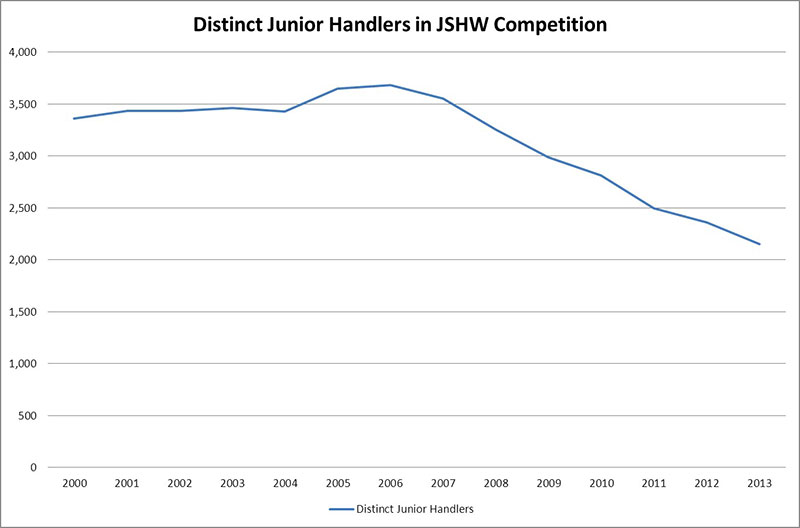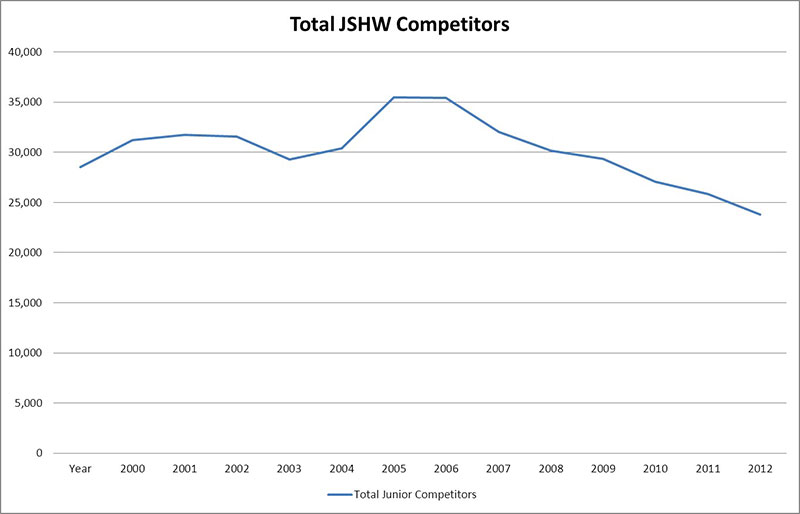Parent Category:
Background
The sport called junior showmanship (JRS) had its beginnings in the late 1920’s. In those early days dog shows were considered a "wealthy-man’s sport"and parents arrived at shows in chauffeur-driven limousines. The children who accompanied their parents quickly became bored causing disruptive problems on the show grounds. In response to this, the American Kennel Club (AKC) created children’s handling events to keep them busy. The judges were local officials, personalities and movie stars. Within a few years AKC replaced local citizens with professional handlers. In 1951 the name of the program was changed to Junior Showmanship. In 1971, the American Kennel Club recognized the virtues of Junior Handler competition and granted official recognition for the classes at AKC events.
The newly- named program required that the competitors be judged "only on the junior’s ability to present his dog quietly, proficiently and to its best advantage."Eligibility for juniors was divided into two classes, Novice and Open, which were further divided by age.
| Novice | Open |
|---|---|
| Junior 9 & under 12 | Junior 9 & under 12 |
| Intermediate 12 & under 15 | Intermediate 12 & under 15 |
| Senior 15 & under 18 | Senior 15 & under 18 |
The first report on the junior survey was called Part I, which was published in the October issue of Perspectives. A PowerPoint presentation given to the delegates in October and is available here.
The Junior Survey
In order to learn more about junior showmanship, a survey was launched that attracted more than 1,300 juniors who responded to a 50 question survey. The purpose of the survey was to identify factors related to success, dropout and continued participation in the sport as an adult. The median age of the respondents at the time of the survey was 39.
While not a part of the survey, it is important to know that AKC data for the years 2000 – 2013 (graph 1& 2) shows a slow downward drift of junior’s participation in the sport over the past 13 years. The entries and certificates awarded juniors by the AKC during this period suggest that several factors may be impacting the program.


The total number of distinct juniors who entered the program by year (Tables 3, 4, 5). Tables 1 and 2 confirm the direction of the program. Economic conditions may be a contributing factor but our survey data suggest that other factors may be involved.
| Year | Comp Type | Distinct Juniors | Total | Total Juniors Competitors |
|---|---|---|---|---|
| 2000 | JSHW | 3,359 | 28,529 | |
| 2001 | JSHW | 3,431 | 31,209 | |
| 2002 | JSHW | 3,4334 | 31,718 | |
| 2003 | JSHW | 3,463 | 31,581 | |
| 2004 | JSHW | 3,427 | 29,273 | |
| 2005 | JSHW | 3,649 | 30,384 | |
| 2006 | JSHW | 3,682 | 35,477 | |
| 2007 | JSHW | 3,550 | 35,408 | |
| 2008 | JSHW | 3,524 | 32,034 | |
| 2009 | JSHW | 2,985 | 30,164 | |
| 2010 | JSHW | 2,810 | 29,368 | |
| 2011 | JSHW | 2,497 | 27,071 | |
| 2012 | JSHW | 2,361 | 25,840 | |
| 2013 | JSHW | 2,151 | 23,780 |
| Year | Junior Numbers Issued | Junior Recognition Certs Issued |
|---|---|---|
| 2001 | 2607 | 259 |
| 2002 | 3015 | 275 |
| 2003 | 3058 | 315 |
| 2004 | 3184 | 341 |
| 2005 | 3109 | 388 |
| 2006 | 2877 | 502 |
| 2007 | 2699 | 480 |
| 2008 | 2269 | 446 |
| 2009 | 2352 | 369 |
| 2010 | 1982 | 399 |
| 2011 | 2322 | 358 |
| 2012 | 2298 | 387 |
| Year | Entry |
|---|---|
| 2001 | 64 |
| 2002 | 65 |
| 2003 | 79 |
| 2004 | ? |
| 2005 | 93 |
| 2006 | 142 |
| 2007 | 135 |
| 2008 | 136 |
| 2009 | 95 |
| 2010 | 123 |
| 2011 | 0148 |
| 2012 | 150 |
| 2013 | 148 |
Preliminary Findings
When asked about success the juniors defined success as winning. For purposes of this study, we defined success as JR’s who spent three or more years in the show ring and were between 15 and 18 years of age.Based on our survey, we noticed that one factor should have been given more attention. Table 6 shows that 49% of the support provided juniors did not involve a family member. This was not expected. The person who provides support to a junior including the all-important transportation to the dog show we call the volunteer.More will be said about this person later in this report and in the final report.
| Support | Frequency | Percent |
|---|---|---|
| No family support | 674 | 49.96 |
| Family support | 675 | 50.04 |
| Other support | 60 | 4.45 |
| No other support | 1289 | 95.55 |
The Breeder of Merit program (BOM) was another topic included in the survey. It was established in 2010, and for many juniors the BOM had not been established during the time they were juniors. However, 37% of the juniors indicted they were a BOM, which confirms their involvement as an adult after aging out.
| Breeder of Merit Program | Frequency | Percent |
|---|---|---|
| Yes | 206 | 37.39 |
| No | 345 | 62.61 |
The requirements for a BOM support our conclusion about continuation in the sport as an adult. BOM requirements include: register dogs you breed, use the health tests of your parent club and belong to a breed club.The responses are encouraging given the young age of this program.
A troubling statistic was the extreme difference in gender (85% girls, 15% boys) which in part can be explained by two social factors. The juniors responded that success was wining. Boys at this age who compete want instant success and are easily embarrassed when they lose to a girl. Girls on the other hand are more patient and are not as easily embarrassed. Discussions with 4-H representatives support these conclusions. We noted that boys at this age lack patience and are easily embarrassed causing them to drop out early if they do not win. Data provided by the Boy and Girl Scouts of America show 55% boys and 45% girls continue to participate in their programs. These differences cannot be explained by ethnicity (Table 8).
| Distribution of Ethnicity | Percentage |
|---|---|
| Caucasian | 31 |
| African-American | 29 |
| Hispanic/Latino | 23 |
| Multi-racial | 5 |
| Asian-American | 3 |
| American Indian or Alaska Native | 3 |
If boys are to be recruited and retained, a better reward and recognition mechanism is needed. New categories other than "winner take all"should be considered. The sport of Junior Showmanship, as currently defined, is based on the traditional thinking of conformation shows where the format of ribbons and 1-4 placements are used to recognize success. Winning and losing is not an attractive reward system to many children of this age.
Preliminary Recommendations
At this time we are only prepared to make a few preliminary recommendations based on our data. One area needing attention is the emphasis that is placed on the volunteer who provides support to the junior.Input from 4H representatives and reports from the Boy and Girl Scouts of America indicate that the ideas used to attract and retain young people and their families need to include values related to the programs and opportunity to enhance skills and personal development.For example, what might be a compelling reason to a junior to become involved in the sport might be different for the adult volunteer who provides the regular and consistent support each show weekend. The adult sees opportunities for self-development, good sportsmanship, social skills, responsibility and time management as values they are likely to appreciate.
In this regard, several research papers about volunteers were reviewed. Wilson reported that people who put more importance on the intrinsic life goals (p 55) support the concept that “motives, values and beliefs” are critical components underlying volunteerism (p. 218). For example, volunteering for one’s church represents a belief system. He discusses the theory of "Human Capital"which includes education, work, and income (pp. 219-222) and explains that the "Level of education is the most consistent predictor of volunteering . . . [and that] education boosts volunteering because it heightens awareness of problems, increases empathy, and builds self-confidence . . . [and] educated people are more likely to be asked to volunteer"(as cited in Wilson, 2000, pp. 219-220).
One recommendation that might address the problem of boys dropping out early is to add credits for participant and increase the number of rewards, ribbons and titles.By adding a component for achievement. more children are likely to remain and less likely to dropout. Earning credits for participation rewards every junior who must prepare, practice, groom and be on time.Rewards and recognition for achievement have worked successfully for the Boy and Girl Scout programs which rely on Merit badges to motivate and drive their programs.
In the final report, Part III, suggestions and recommendations will be based on the data, input from 4H and Boy and Girls Scouts and other organizations interested in creating a fan base.
Reference
Wilson, John , 2000. Volunteering, Annual Review of Sociology, Vo. 26, (2000) pp. 215 -240
About the Author
Carmen L Battaglia holds a Ph.D. and Masters Degree from Florida State University. As an AKC judge, researcher and writer, he has been a leader in promotion of breeding better dogs and has written many articles and several books.Dr. Battaglia is also a popular TV and radio talk show speaker. His seminars on breeding dogs, selecting sires and choosing puppies have been well received by the breed clubs all over the country.

